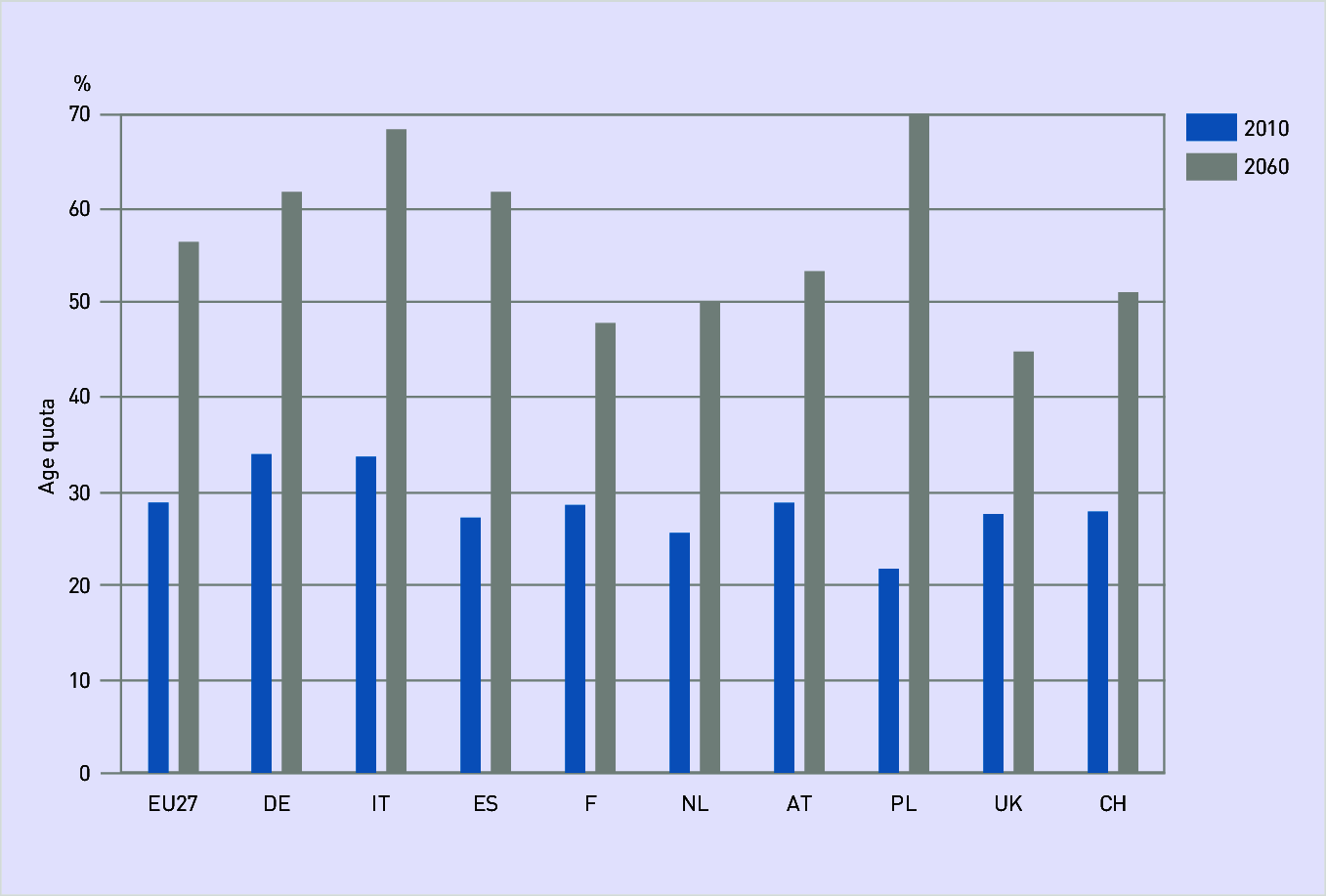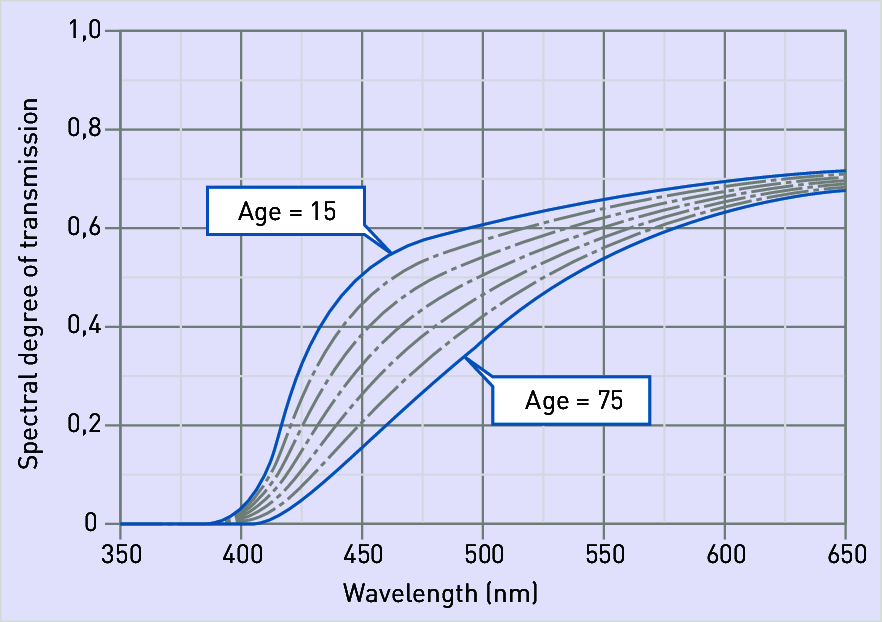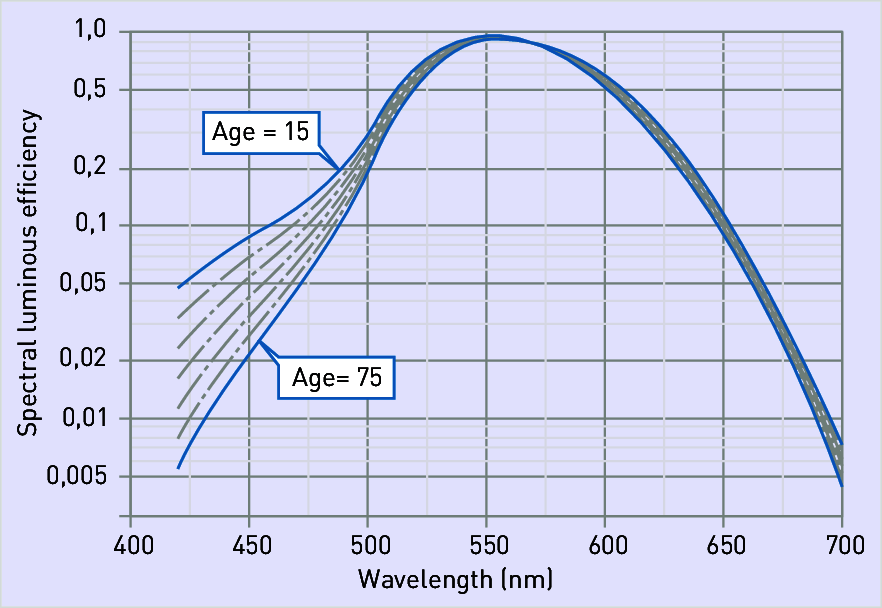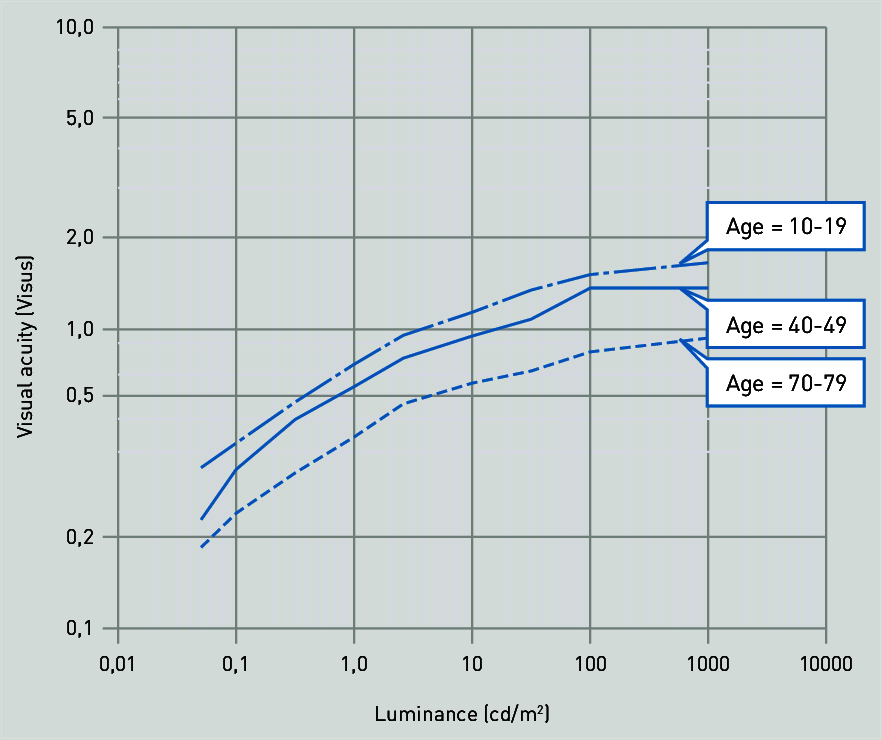More than 80% of our sensations are visual in nature. Old people, however, suffer from limited perception of their environment due to increasing debility of sight, which limits their ability to communicate with other people.
Vision with increasing age
Visual performance of the human eye, and visual acuity in particular (figure), decreases with increasing age, and consequently the need for light becomes greater. This has several causes: Young and healthy eyes can adjust to up to 20 dioptres for distance vision. The ciliary muscle, which changes the shape of the eye lens and thus its refraction power, is relaxed with distance vision. Here, the eye lens is flat with a great curvature radios and infinite focal length. When the ciliary muscle contracts, the eye is adjusted to close vision and the biconvex eye lens is shaped spherically with a small curvature radios and short focal length due to its elasticity.
When the eye lens hardens, the ciliary muscle can no longer adjust the eye lens to the required refraction power. The accommodation facility (focussing) is limited (presbyopia). Presbyopia can be corrected using optical devices (glasses).

Figure 3.134: Age quota in the EU: Average value of the 27 EU states (EU27) and some EU states in 2010 and 2060
Accommodation time also prolongs with age: A 40-year-old takes approximately twice as much time as a 20-year-old (ca. 0,7 sec.) to adjust from 50 cm to infinite.
The degree of transmission of the eye lens also deteriorates with age. The most common cause for this is a slow process resulting in clouding of the lens (cataract). The diffused light it creates spreads across the retina like a veil. Consequently, the retinal image becomes "blurred ", outlines and contrasts become fuzzy, visual acuity decreases and glare sensitivity increases (veiling luminance). In advanced cases, a replacement lens can be implanted to restore visual performance.
The spectral degree of transmission of eye lens also changes. Due to yellow clouding (figure), mainly short wavelengths (violet to green) are absorbed and only reach the retina in a reduced amount (figure). This has the following consequences:
Colour perception shifts. Violet to green colour tones are perceived to a lesser extent than yellow and red tones.
Colour nuances are recognised less clearly.
Spectral sensitivity in a 15-year-old person, e.g. at 430 nm (blue light) is increased by the factor 10 compared to a 75-year-old person (figure). This means that the melanopic response to blue radiation, which is responsible for the biological rhythm, is reduced in the older person. Melatonin level control (serum for sleep requirement) and consequently sleeping behaviours of older people thus change unfavourably. A lack of activity during the day and sleep disorders at night can be the result (see also chapter "Light and non-visual effects").
The field of vision also narrows with age. In younger people, the horizontal extent with good contrast in the visual detail is around ± 60°; for older people it is a mere ± 40°. Peripheral perception thus becomes limited. This must be taken into account e.g. when arranging signage, which must be installed lower than usual to accommodate for people with disabilities, who tend to look downwards out of a feeling of insecurity, or wheelchair users.
Age-related debility of sight is often accompanied by illness-related defects, which significantly reduce visual performance – and usually do not have a chance of recovery. Visual impairment is established once visual acuity with ideal corrective measures has decreased to 0,1.
Roughly 50% of visual impairments are caused by age-related macular degeneration (AMD), which is the most common cause of blindness above the age of 50. It concerns mainly the sharpest point of vision (fovea centralis).
Another 18% of visual impairments are due to glaucoma which is a consequence of elevated intraocular pressure which causes ganglion cells to die, generates damage to the visual nerve and continuously narrows the field of vision.
Diabetic retinopathy accounts for 17% of visual impairments, the cause being diabetes (excessive blood sugar levels due to insulin deficiency), which damages blood vessels in the retina as well as photoreceptors.
5% of visual impairments are due to cataract (clouding of the lens). The number is this low due to the fact that – as described above – visual performance can be restored by implanting a new lens.

Figure 3.132: Luminous efficiency of the human eye in old age

Figure 3.133: Spectral degree of transmission of the human eye

Figure 3.135: Visual acuity and required luminance in old age. Comment: A visual acuity of 1 (Visus 1,0) means that a detail of 1,5 mm in size is recognised at a distance of 5,0 m.